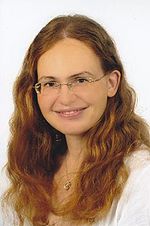Difference between revisions of "Labieniec-Watala 2012 Abstract Bioblast"
| Line 1: | Line 1: | ||
{{Abstract | {{Abstract | ||
|title=Labieniec-Watala M, Siewiera K, Watala C (2012) Seasonal fluctuations affect the physiology of laboratory animals – | |title=Labieniec-Watala M, Siewiera K, Watala C (2012) Seasonal fluctuations affect the physiology of laboratory animals – facts and artifacts from the perspective of heart mitochondrial respiratory response to tested compounds. Mitochondr Physiol Network 17.12. | ||
|info=[[MiPNet17.12 Bioblast 2012|MiPNet17.12 Bioblast 2012 - Open Access]] | |info=[[MiPNet17.12 Bioblast 2012|MiPNet17.12 Bioblast 2012 - Open Access]] | ||
|authors=Labieniec-Watala M, Siewiera K, Watala C | |authors=Labieniec-Watala M, Siewiera K, Watala C | ||
Revision as of 00:12, 17 November 2012
| Labieniec-Watala M, Siewiera K, Watala C (2012) Seasonal fluctuations affect the physiology of laboratory animals – facts and artifacts from the perspective of heart mitochondrial respiratory response to tested compounds. Mitochondr Physiol Network 17.12. |
Link: MiPNet17.12 Bioblast 2012 - Open Access
Labieniec-Watala M, Siewiera K, Watala C (2012)
Event: Bioblast 2012
All living organisms are subject to biorhythmic energetic fluctuations. Usually, it is associated with a pathological background relevant to aging or diseases. However, it can be also linked to the compromising of the survival under unfavorable environmental conditions, such as hypoxia, hypothermia or the lack of food. Recently, several pieces of evidence have been accumulated, showing that seasonal variations can play an essential role in the metabolism, behavior and activity of the laboratory animals. These observations are consistent data (originating from both in vitro and in vivo experiments) demonstrating that mitochondria isolated from rats in the autumn-winter period are characterized by the “respiratory depression”, while the mitochondria derived from spring-summer animals seem to be less sensitive to tested compounds and characterized by more efficient respiratory capacity. The objective of our presentation is to show the effect of seasonality on mitochondrial bioenergetics and - in consequence, the further interpretation of the study outcomes. Using rat heart mitochondria as a model, and PAMAM dendrimer G3 and methylglyoksal (MG) as the tested chemicals, we have revealed significant differences in the mitochondrial response when carrying out our experiments and acquiring data throughout the year (September – June). The obtained data give a possibility to assume that lower respiratory capacity of mitochondria derived from the autumn-winter period is likely to result from suppressed energy metabolism and metabolic depression. Mitochondrial parameters, such as RCR and ADP/O, were significantly increased for animals derived in spring administered with the tested compounds. These data support the reasoning that in spring period mitochondria are in a better condition compared to those tested in the autumn/winter period. Therefore, it is noteworthy to remark that in order to obtain the reliable conclusions, the aspect of seasonal changes in laboratory animals should be taken into consideration at the experimental design of the study lasting a few months and spanning for a longer period including different seasons. Finally, it is important to emphasize that there is a high probability that some outcomes derived merely from the in vitro experiments may never have their absolute relevance to clinical studies.
• Keywords: Seasonal fluctuations, Heart mitochondria bioenergetics, ATP production
• O2k-Network Lab: PL Lodz Watala C
Labels:
Stress:RONS; Oxidative Stress"RONS; Oxidative Stress" is not in the list (Cell death, Cryopreservation, Ischemia-reperfusion, Permeability transition, Oxidative stress;RONS, Temperature, Hypoxia, Mitochondrial disease) of allowed values for the "Stress" property., Mitochondrial Disease; Degenerative Disease and Defect"Mitochondrial Disease; Degenerative Disease and Defect" is not in the list (Cell death, Cryopreservation, Ischemia-reperfusion, Permeability transition, Oxidative stress;RONS, Temperature, Hypoxia, Mitochondrial disease) of allowed values for the "Stress" property. Organism: Mouse, Rat Tissue;cell: Cardiac muscle"Cardiac muscle" is not in the list (Heart, Skeletal muscle, Nervous system, Liver, Kidney, Lung;gill, Islet cell;pancreas;thymus, Endothelial;epithelial;mesothelial cell, Blood cells, Fat, ...) of allowed values for the "Tissue and cell" property., Fibroblast, Hepatocyte; Liver"Hepatocyte; Liver" is not in the list (Heart, Skeletal muscle, Nervous system, Liver, Kidney, Lung;gill, Islet cell;pancreas;thymus, Endothelial;epithelial;mesothelial cell, Blood cells, Fat, ...) of allowed values for the "Tissue and cell" property., Blood Cell; Suspension Culture"Blood Cell; Suspension Culture" is not in the list (Heart, Skeletal muscle, Nervous system, Liver, Kidney, Lung;gill, Islet cell;pancreas;thymus, Endothelial;epithelial;mesothelial cell, Blood cells, Fat, ...) of allowed values for the "Tissue and cell" property. Preparation: Homogenate, Isolated Mitochondria"Isolated Mitochondria" is not in the list (Intact organism, Intact organ, Permeabilized cells, Permeabilized tissue, Homogenate, Isolated mitochondria, SMP, Chloroplasts, Enzyme, Oxidase;biochemical oxidation, ...) of allowed values for the "Preparation" property.
Coupling state: LEAK, ROUTINE, OXPHOS, ETS"ETS" is not in the list (LEAK, ROUTINE, OXPHOS, ET) of allowed values for the "Coupling states" property.
HRR: Oxygraph-2k, TIP2k
Affiliations and author contributions
Labieniec-Watala M (1), Siewiera K (2), Watala C (2)
(1) University of Lodz, Faculty of Biology and Environmental Protection, Department of Thermobiology, Poland; Email: magdalab@biol.uni.lodz.pl
(2) Department of Haemostasis and Haemostatic Disorders, Medical University of Lodz, University Clinical Hospital, Poland; Email: ksiewiera@gmail.com (K.Siewiera); cezary.watala@umed.lodz.pl (C. Watala)
